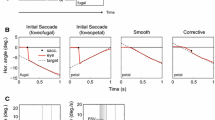Summary
The oculomotor reactions have recently attracted increasing attention for diagnostic purposes. This is in line with the view that the oculomotor system is one of the simpler, machine-like sensorimotor systems. This paper presents two examples to demonstrate that the complexity of sensorimotor processing may be higher than expected from the outcome of experiments under rather restricted stimulus conditions. In the first part it is shown that complex preprocessing including the evaluation of spatial gradients of visual structure is an integral part of the programming of reflex-like saccades. The second part concerns adaptivity of saccadic eye movements. The data demonstrate that saccadic gain control is highly specific to the direction of the saccade. It is suggested that many central deficits may be hidden as a consequence of the effect of specific adaptive mechanisms.
Similar content being viewed by others
References
Bender MB (1980) Brain control of conjugate horizontal and vertical eye movements. A survey of the structural and functional correlates. Brain 103:23–69
Deubel H (1987) Adaptivity of gain and direction in oblique saccades. In: O'Regan JK, Levy-Schoen A (eds) Eye movements: from physiology to cognition. Elsevier North Holland, Amsterdam, pp 181–190
Deubel H, Hauske G (1988) The programming of visually guided saccades. In: Marko H, Hauske G, Struppler A (eds) Processing structures for perception and action. Verlag Chemie, Weinheim, pp 119–132
Deubel H, Wolf W, Hauske G (1982) Corrective saccades: effect of shifting the saccade goal. Vision Res 22:353–364
Deubel H, Wolf W, Hauske G (1984) The evaluation of the oculomotor error signal. In: Gale AG, Johnson FW (eds) Theoretical and applied aspects of eye movement research. Elsevier North-Holland, Amsterdam, pp 55–62
Deubel H, Wolf W, Hauske G (1986) Adaptive gain control of saccadic eye movements. Hum Neurobiol 5:245–253
Deubel H, Findlay JM, Jacobs AM, Brogan B (1988) Saccadic eye movements to targets defined by structure differences. In: Luer G, Lass U, Shallo-Hoffmann J (eds) Eye movement research: physiological and psychological aspects. Hofgrefe, Toronto, pp 107–145
Dichgans J (1978) Oculomotor signs of cerebellar diseases. In: Kommerell G (ed) Disorders of ocular motility: neurophysiological and clinical aspects. Bergmann, Munich, pp 235–248
Findlay JM (1982) Global processing for saccadic eye movements. Vision Res 22:1033–1045
Fischer B, Ramsperger E (1984) Human express saccades: extremely short reaction times of goal directed eye movements. Exp Brain Res 57:191–195
Gaebel W, Ulrich G (1987) Visuomotor tracking performance in schizophrenia: Relationship with psychopathological subtyping. Neuropsychobiol 17:66–71
Gaebel W, Ulrich G, Frick K (1987) Visuomotor performance of schizophrenic patients and normal controls in a picture viewing task. Biol Psychiatry 22:1227–1237
Gonshor A, Melvill-Jones G (1973) Changes of human vestibulo-ocular response induced by vision-reversal during head rotation. J Physiol (Lond) 234:102
Henn V, Büttner U (1982) Disorders of horizontal gaze. In: Lennerstrand G, Zee DS, Keller EL (eds) Functional basis of oculomotor disorders. Pergamon Press, Oxford
Henn V, Hepp K, Büttner-Ennever JA (1982) The primate oculomotor system. II. Premotor system. Hum Neurobiol 1:87–95
Holzman PS, Levy DL, Proctor LR (1977) Smooth pursuit eye movements and functional psychoses; a review. Schizophr Bull 3:15–27
Latto R, Cowey A (1971) Visual field defects after frontal eyefield lesions in monkeys. Brain Res 30:1–24
Mather JA, Putchat C (1983) Motor control of schizophrenics I. Oculomotor control of schizophrenics: a deficit processing, not strictly in motor control. J Psychiatr Res 17:343–360
McLaughlin SC (1967) Parametric adjustment in saccadic eye movements. Percept Psychophysics 2:359–362
Optican LM, Miles FA (1985) Visually induced adaptive changes in primate oculomotor control signals. J Neurophysiol 5:940–958
Optican LM, Zee DS, Chu FC (1985) Adaptive changes due to ocular muscle weakness in human persuit and saccadic eye movements. J Neurophysiol 54:110–122
Schiller P (1985) A model for the generation of visually guided eye movements. In: Rose D, Dobson VG (eds) Models of the visual cortex. Wiley, New York, pp 62–70
Schiller P, Sandell JH, Maunsell JHR (1987) The effect of frontal eye field and superior colliculus lesions on saccadic latencies in the rhesus monkey. J Neurophysiol 57:1033–1049
Schmid-Burgk W, Becker W, Jürgens R, Kornhuber HH (1983) Saccadic eye movements in psychiatric patients. Neuropsychobiology 10:193–198
Shagass C, Amadeo M, Overton DA (1974) Eye-tracking performance in psychiatric patients. Biol Psychiatr 9:245–260
Zihl J, Cramon D von (1978) Perimetrische Funktionsprüfung des Colliculus Superior. Nervenarzt 49:488–491
Author information
Authors and Affiliations
Rights and permissions
About this article
Cite this article
Deubel, H. Sensory and motor aspects of saccade control. Eur Arch Psychiatr Neurol Sci 239, 17–22 (1989). https://doi.org/10.1007/BF01739738
Received:
Issue Date:
DOI: https://doi.org/10.1007/BF01739738




